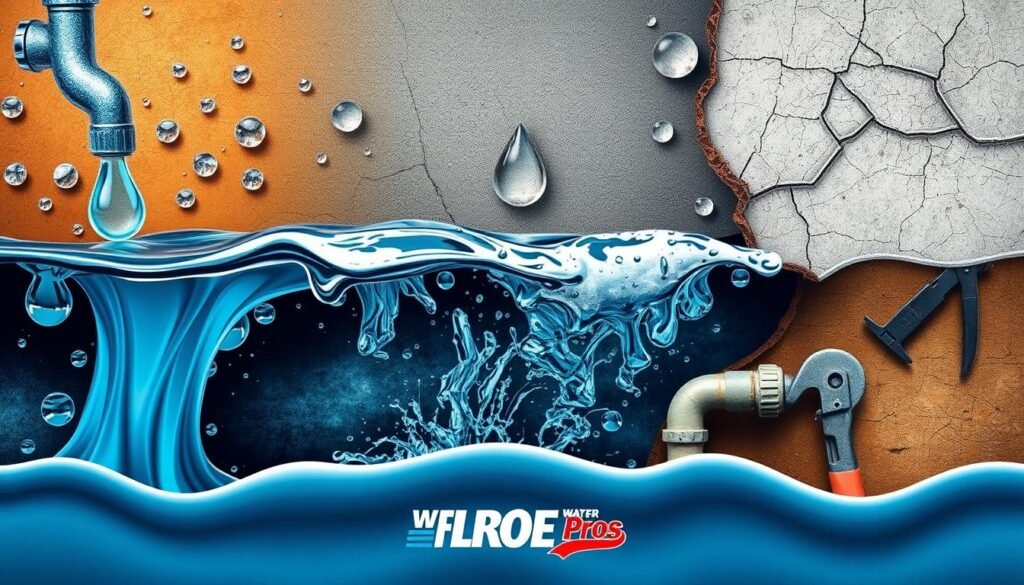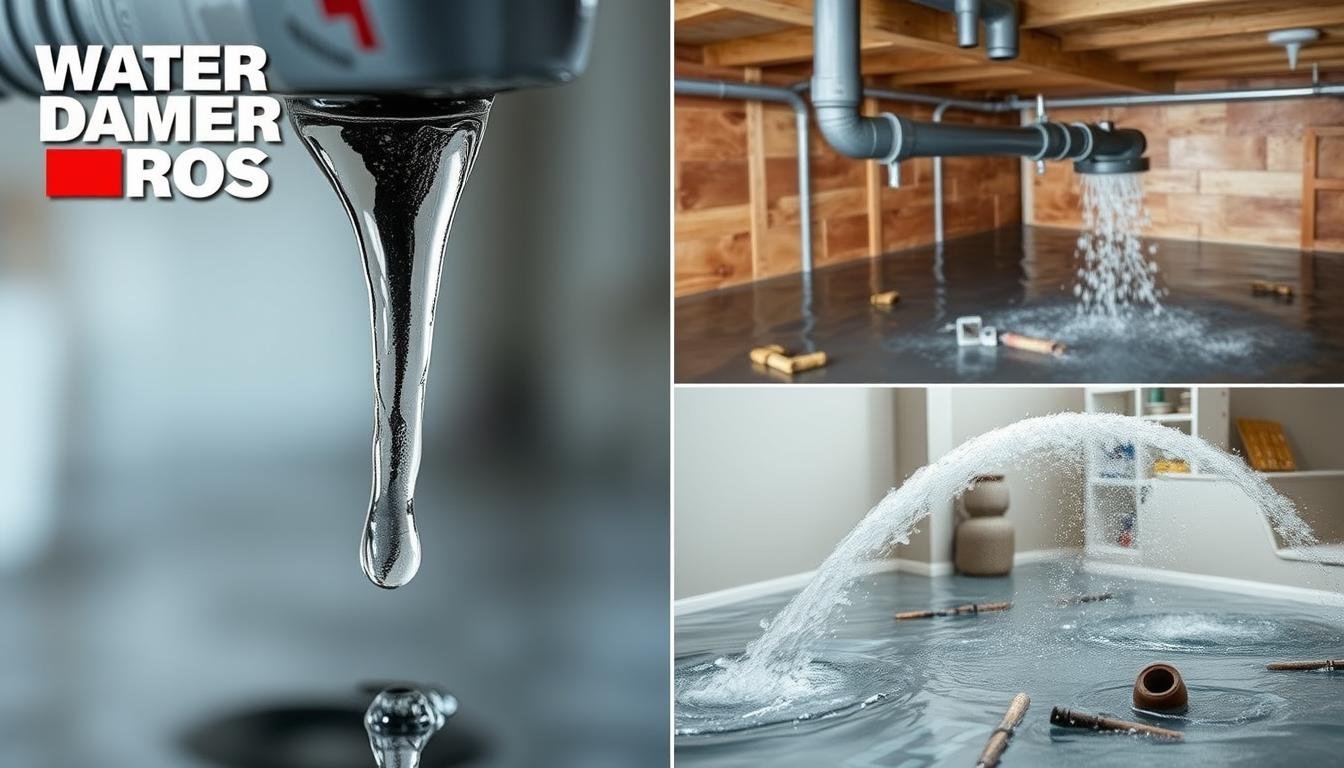Water damage is a nightmare for homeowners, leading to expensive repairs and disruptions. Leaks and burst pipes are major culprits, making regular checks and upkeep essential1. Knowing what causes water damage is key to protecting your home.
This article will dive into common water damage sources and how to dodge them. We’ll look at leaks, burst pipes, plumbing issues, and roof problems. You’ll get tips to keep your home safe from water damage12.
Key Takeaways
- Leaks and burst pipes are a leading cause of water damage in homes, emphasizing the need for regular inspection and maintenance.
- Faulty plumbing systems can contribute to water leaks and flooding, highlighting the importance of proper maintenance and prompt repairs.
- Damaged or poorly maintained roofs can result in water infiltration, emphasizing the necessity of regular roof inspections and repairs.
- Basements are susceptible to flooding if not properly waterproofed, suggesting preventive measures like installing a sump pump or sealing cracks.
- Appliance malfunctions can be a source of water leaks, stressing the importance of regular maintenance and prompt repairs.
Understanding the Categories of Water Damage
Water damage is divided into different types based on the source and contamination level3. Knowing these categories helps us understand how serious the damage is. This knowledge guides us in choosing the right steps to fix it. Let’s look at the three main types: clean water, grey water, and black water.
Category 1: Clean Water Damage
Category 1 water comes from sources that are safe for humans45. This includes leaks from pipes, broken appliances, and overflowing sinks or tubs3. This type of water is clean and can be fixed easily.
Category 2: Grey Water Damage
Category 2 water has more contamination than clean water435. It comes from things like washing machine overflows, dishwasher leaks, and toilet overflows (not sewage). While not as dangerous as black water, it still needs careful handling to avoid health risks.
| Water Damage Category | Contamination Level | Examples |
|---|---|---|
| Category 1: Clean Water | Minimal | Broken supply lines, leaking appliances, overflowing sinks/bathtubs |
| Category 2: Grey Water | Moderate | Washing machine overflow, dishwasher leaks, toilet overflows (excluding sewage) |
| Category 3: Black Water | Severe | Sewage backup, flooding from natural disasters, standing water with microbial growth |

“Regardless of the category, any form of unaddressed water damage can lead to structural issues and mold growth if not properly remediated in a timely manner.”
It’s key to correctly identify and categorize water damage for safe and effective restoration3. By knowing the contamination levels, we can take the right steps to prevent more damage. This protects the health and safety of everyone involved435.
Causes and Common Sources of Water Damage
Homeowners need to watch out for water damage sources to protect their homes. Leaking or burst pipes, plumbing problems, and roofing issues can all cause water damage. These problems can lead to expensive repairs.
Leaking or Burst Pipes
Leaking or burst pipes are a common cause of water damage. They can happen due to old age, corrosion, or extreme weather. It’s important to check pipes regularly and fix plumbing issues fast to avoid damage6.
Even a small leak can cause a lot of damage, costing thousands to fix6. Insulating exposed pipes and monitoring water pressure can help prevent these problems.
Plumbing System Issues
Malfunctions in plumbing systems can also lead to water damage6. Old water heaters often leak, so regular maintenance is key6. Clogged drains can cause flooding if not fixed quickly6.
A leaking washing machine can flood a laundry room fast if not stopped6. Keeping plumbing in good shape and fixing problems quickly is crucial.
Roofing Problems
Roofing issues like leaks and clogged gutters can also cause water damage6. Clogged gutters can overflow and damage ceilings, walls, and floors6. Severe weather can also lead to water damage, especially in flood-prone areas6.
Regular roof checks, gutter cleaning, and quick repairs are key to preventing water damage.
| Cause of Water Damage | Likelihood of Occurrence | Potential Damage |
|---|---|---|
| Leaking or Burst Pipes | 6Cases where a little amount of water has caused damage costing tens of thousands of dollars to repair and restore have been reported. | Extensive water leakage and significant damage |
| Plumbing System Issues | 6The likelihood of an old water heater eventually springing a leak is high6,Clogged drains can easily back up and cause flooding and water damage if not addressed immediately. | Flooding, water damage, and mold growth |
| Roofing Problems | 6Clogged gutters can cause water damage to ceilings, walls, and floors if rainwater overflows due to blockages6,Thunderstorms, hurricanes, and other severe weather events can lead to water damage on properties, especially in flood-prone areas. | Water intrusion, ceiling and wall damage, and potential structural issues |
Understanding water damage causes and taking action can help homeowners avoid expensive repairs7. About 40% of homeowners have faced water damage, and7 93% of water damage could be prevented with the right knowledge7.
sources of water damage
Basements are often at risk of flooding. It’s important to take steps to prevent water damage. Heavy rains can lead to water entering the basement through cracks or poor drainage8. Homeowners should seal cracks, maintain gutters, check sump pumps, and ensure water flows away from the foundation8.
Basement Flooding
Water damage from leaking or broken pipes is common8. Changes in water pressure or freezing can burst pipes8. Even small leaks can cause a lot of damage over time8. It’s key to spot moisture early to avoid bigger problems8.
Appliance Malfunctions
Broken appliances like washing machines, dishwashers, and water heaters can leak and damage your home89. Keeping these appliances in good shape is vital89. Forgetting to turn off faucets can overflow water, harming floors and ceilings8.
Fixing the causes of water damage, like basement flooding and appliance issues, is key to protecting your home. By being proactive, you can avoid expensive damage and keep your space safe.
“Water damage can be a homeowner’s worst nightmare, but with the right preventative measures, it can be managed and mitigated effectively.”
Conclusion
Water damage can be a big problem for homeowners. But, by knowing the common causes and taking steps to prevent them, you can protect your home. This can help avoid expensive repairs10.
There are many things that can cause water damage, like leaks or burst pipes. Roofing issues, basement flooding, and appliance problems are also common101112.
By following the tips in this article, you can keep your home safe and worry-free101112. Regular checks on your plumbing, fixing roof leaks, and keeping appliances in good shape are key101112.
Water damage can harm your home’s structure, cause mold, and even make your water unsafe12. Taking action to protect your home can save you from costly and stressful problems. It helps keep your home’s value and safety101112.
FAQ
What are the common sources of water damage in homes?
How are the categories of water damage classified?
What are the key factors that contribute to leaking or burst pipes?
How can I prevent basement flooding?
What are some common appliance malfunctions that can cause water damage?
Source Links
- https://www.cbcomplete.com/common-cause-of-water-damage-explained/
- https://www.bigbearrestoration.com/blog/2023/august/an-overview-of-the-different-categories-of-water/
- https://rainbowrestores.com/blog/types-of-water-damage
- https://www.servpro.com/resources/water-damage/three-categories-of-water-damage-for-insurance
- https://www.mcmahonservices.com/classifications-of-water-damage/
- https://www.thesilverlining.com/westbendcares/blog/what-are-the-common-causes-of-water-damage
- https://www.bmscat.com/blog/7-most-common-causes-of-residential-water-damage/
- https://www.servicemasterrestore.com/blog/water-damage/top-causes-of-water-damage-at-home-and-how-you-can-prevent-them/
- https://connectedsensors.com/blog/causes-of-water-damage/
- https://en.wikipedia.org/wiki/Water_damage
- https://krapflegal.com/recources/water-damage/water-damage-statistics-key-insights-and-trends-for-homeowners/
- https://remgroupinc.com/blog/understanding-water-damage-what-gets-ruined/


